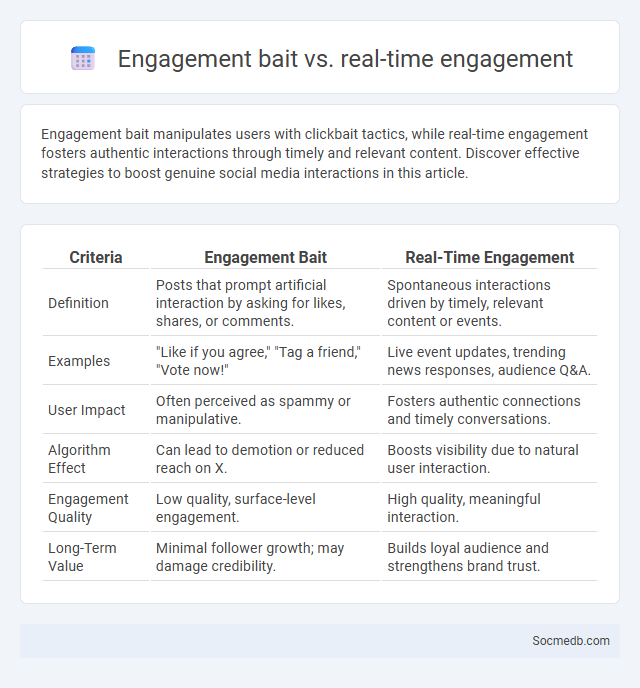
Photo illustration: Engagement bait vs Real-time engagement
Engagement bait manipulates users with clickbait tactics, while real-time engagement fosters authentic interactions through timely and relevant content. Discover effective strategies to boost genuine social media interactions in this article.
Table of Comparison
| Criteria | Engagement Bait | Real-Time Engagement |
|---|---|---|
| Definition | Posts that prompt artificial interaction by asking for likes, shares, or comments. | Spontaneous interactions driven by timely, relevant content or events. |
| Examples | "Like if you agree," "Tag a friend," "Vote now!" | Live event updates, trending news responses, audience Q&A. |
| User Impact | Often perceived as spammy or manipulative. | Fosters authentic connections and timely conversations. |
| Algorithm Effect | Can lead to demotion or reduced reach on X. | Boosts visibility due to natural user interaction. |
| Engagement Quality | Low quality, surface-level engagement. | High quality, meaningful interaction. |
| Long-Term Value | Minimal follower growth; may damage credibility. | Builds loyal audience and strengthens brand trust. |
Understanding Engagement Bait: What It Is and How It Works
Engagement bait refers to social media posts designed to manipulate algorithms by prompting users to like, share, comment, or react in specific ways to boost visibility. Platforms like Facebook and Instagram actively demote such content to maintain authentic user interactions and improve feed quality. Understanding this tactic helps you create genuine posts that foster meaningful connections without risking reduced reach or penalties.
Real-Time Engagement: Definition and Key Features
Real-time engagement in social media refers to the immediate interaction between users and content, characterized by instant responses, live streaming, and real-time analytics. Key features include live chat capabilities, instant notifications, and dynamic content updates that keep your audience actively involved. This approach enhances user experience by fostering timely conversations and strengthening community connections.
The Rise of Engagement Bait on Social Media Platforms
Engagement bait tactics on social media platforms have surged, leveraging emotionally charged content and clickbait to manipulate user interactions. These strategies exploit platform algorithms by encouraging likes, shares, comments, and reactions, artificially inflating engagement metrics. Facebook and Instagram have implemented algorithm updates to reduce the visibility of engagement bait posts, aiming to promote authentic interactions and improve user experience.
Real-Time Engagement vs Engagement Bait: Core Differences
Real-time engagement on social media involves authentic, timely interactions that foster genuine connections and community growth, while engagement bait relies on manipulative tactics designed to artificially boost likes, shares, or comments. Real-time engagement values meaningful conversations and responsiveness, contributing to long-term audience trust and platform algorithm favorability. Understanding these core differences helps you create content that encourages organic interactions, enhancing your social media reputation and reach.
Why Engagement Bait Harms Your Social Media Presence
Engagement bait tactics exploit social media algorithms by prompting users to like, comment, or share content with obvious calls to action, which can lead to reduced organic reach and lower credibility for your brand. Platforms like Facebook and Instagram actively penalize posts using engagement bait, decreasing visibility and inhibiting genuine community growth. Protecting your social media presence requires creating authentic content that naturally encourages interaction, fostering meaningful connections rather than relying on manipulative tactics.
Benefits of Real-Time Engagement for Authentic Interaction
Real-time engagement on social media fosters authentic interaction by enabling immediate feedback and dynamic conversations, increasing user trust and loyalty. Brands leveraging live responses and instant messaging create personalized experiences that enhance customer satisfaction and brand affinity. This immediacy also boosts social media algorithms' favorability, amplifying organic reach and driving higher engagement rates.
Algorithms and Their Response to Engagement Bait
Social media algorithms prioritize authentic user interactions by detecting and penalizing engagement bait tactics designed to artificially inflate likes, shares, or comments. Platforms like Facebook and Instagram have developed machine learning models to identify repetitive or spammy engagement prompts, thereby reducing their reach and visibility. This algorithmic response aims to maintain content quality and promote genuine user engagement across the network.
Best Practices for Genuine Real-Time Engagement
Maximizing genuine real-time engagement on social media requires prompt responses, authentic interactions, and utilizing platform-specific features like Instagram Stories' question stickers or Twitter polls. Brands should monitor trending topics with social listening tools to join relevant conversations genuinely while maintaining transparency and a consistent brand voice. Real-time data analytics help optimize posting times and content types, increasing user interaction and fostering a loyal community.
Case Studies: Successes and Failures of Engagement Strategies
Case studies on social media engagement reveal that personalized content and interactive campaigns significantly boost user participation and brand loyalty, as demonstrated by Coca-Cola's "Share a Coke" campaign which increased sales by 2%. Conversely, failed strategies often involve neglecting audience feedback or misreading cultural sensitivities, exemplified by Pepsi's controversial 2017 ad that led to widespread backlash and brand damage. These analyses underscore the importance of data-driven targeting and authentic communication in crafting effective social media strategies.
Building Sustainable Social Media Engagement Strategies
Building sustainable social media engagement strategies involves consistently delivering valuable content tailored to your target audience's preferences and behaviors. You should leverage data analytics to identify peak interaction times and optimize posting schedules, fostering authentic connections that encourage ongoing participation. Prioritizing community interaction and responsive communication strengthens trust and long-term audience loyalty across platforms.
 socmedb.com
socmedb.com